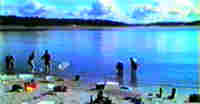|

They
are wonderful
|
|
Wave exposure can for example vary along
different coastlines, on different beaches and even along the same beach.
Furthermore, dehydration, particle size, organic and oxygen content vary
at different depths within the bottom sediment. All these factors facilitate
an abundance of environments and therefore a wealth and variety of living
creatures along sand beaches - in spite of what may on the surface appear,
lifeless.
The art of digging
Those organisms that live on sandy bottoms,
and can dig down into it, have several advantages. For example::
Hide from their enemies.
Protection from dehydration.
Less risk of being washed away.
Increased possibilities of finding food.
Most of the larger creatures exploit some form of physical
attribute in the sand that can make digging easier. You have certainly
noticed that when you tread on wet sand, how it becames drier, harder
and lighter in colour. When the water content of the sediment weighs less
than 22% of the total weight, and it is compressed, its structure changes.
The water does not fill the spaces between the sand grains anymore. The
sedimentet becames hard and resistant.
Tixotropi
Instead of compressing the sand with your
foot make small light movements in the sand that has more than 25% water,
the sediment becames softer and less viscos (quicksand). When, under these
circumstances the sediment is exposed to pressure, its structure changes,
and a sludge of water and sand grains is created. This phenomenon is known
as tixotropi.
|

|
Page 6
of 15
|

|
|